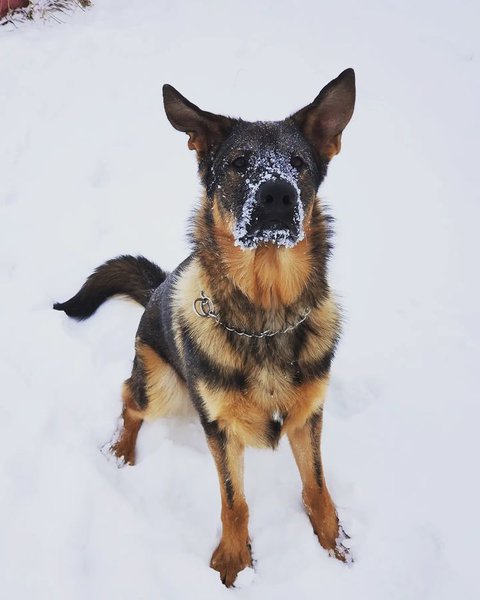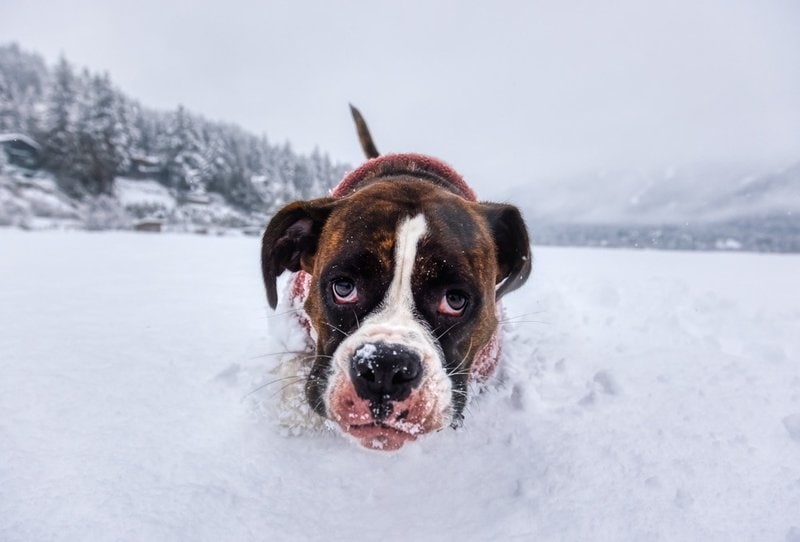During winter, waking up to snowfalls can be frustrating, especially when the weather is cold and unfriendly and you find it difficult to go about your usual daily activities. There are times when even getting out of the house becomes a challenge — let alone walking your dog!
Frostbites are common occurrences, especially during winter. It is an injury that affects the skin and underlying tissues caused by extreme cold. When it happens to people, frostbite can be very painful and takes a long time to heal. It is common with humans, but if you are a dog owner, you may be wondering – can dogs get frostbite?
Yes, dogs can get frostbite. Dogs are at risk of frostbite when exposed to extreme cold for extended periods. During the winter months, dogs who live outside or have access to an outdoor kennel are at a higher risk for frostbite than most pets. These dogs are exposed to extreme cold without proper protection from clothing or shelter.
You may be wondering what the signs of frostbite are and what to do if your dog has frostbite. I have covered these topics in this article but before then, let’s look at what causes frostbite in dogs.
What Causes Frostbite In Dogs?

Frostbite is caused by extremely low temperatures. It occurs when your dog’s body temperature starts to drop below the normal level and freezes the fluids in their cells. It most commonly affects the extremities, such as toes, fingers, nose, ears, and cheeks.
Dogs with short muzzles, like Pugs and Bulldogs, are also at a higher risk for frostbite than other breeds because their noses and mouths make up such a large portion of their bodies. In addition, certain dog breeds like Australian Shepherds and Siberian Huskies have double coats that tend to trap more body heat than other single-coated breeds.
What Are The Three Stages Of Frostbite In Dogs?
Frostbite in dogs can occur in three main stages: frostnip, superficial frostbite, and deep frostbite.
Frostnip
Frostnip is the first stage of frostbite. Frostbite occurs when your dog’s skin is exposed to temperatures below freezing for only a few minutes. It causes mild skin irritation that leads to numbness of your dog’s skin.
Superficial
This is the next stage after frostnip. At this stage, blisters may appear after a day or two.
Deep Frostbite
This is a severe stage of frostbite. Your dog will experience numbness in the skin, and your pooch’s joint may stop working. At this stage, you will need to contact the vet immediately.
Signs Of Frostbite In Dogs
Frostbite comes with a few symptoms that are very visible. If your dog was out in the cold and you suspect your pooch is frostbitten, then you should look out for the following symptoms.
Cold Skin
In the affected area, your dog will have skin that is constantly cold to the touch. The cold skin will unusually remain for a longer time than normal, even with your body heat. Sometimes, the cold may spread to other parts of your dog’s body.
Constant Pain And Swelling
Your dog will also experience pain in the area of the frostbite. The pain results from the freezing of your dog’s skin and cells. You will also notice swelling in parts of your dog’s skin where the frostbite is. The swelling can be mild, and it can also be very visible and severe.
Blisters
Another symptom you will notice in your canine is blisters. Blisters usually occur due to damage to the part of your dog’s skin where the frostbite is seen. Always check your dog to see if there are symptoms of blisters. If you notice blisters along with cold skin, then your canine may be having frostbite.
Black Or Blue Skin
When frostbite worsens in your dog, you will notice that your dog’s skin will turn black or blue. This results from dead cells due to freezing, and it is the worst form of frostbite. When this happens, it means the skin cell is dead, and not much can be done about it.
It might not be very visible due to your pooch’s fur, but if you suspect that your dog has frostbite, you should open up the fur and check for signs of blue or black skin.
How Do You Know If Your Dog Has Frostbite?

The best way to tell if your dog has frostbite is to watch for a few warning signs. Your dog may have a pale nose or ears and might be shaking paws. The area around your dog’s ears and feet might turn blue. The affected skin might also appear pale or bluish.
Other symptoms you may notice are swelling of the affected part, black skin resulting from dead cells, blisters, and even the discoloration of some parts of your dog’s body. If you see any of these symptoms, immediately take your pooch to the vet.
How Long Does It Take For A Dog To Get Frostbite?
How long it takes for your dog to develop frostbite is dependent on how cold and how low the temperature of the environment is. In a snowy and freezing condition, your dog may have frostbite in as little as thirty minutes to several hours of exposure to cold.
As a dog owner, frostbite is one of those things you wouldn’t want your dog to have. If you take your dog out on a snowy day, do not stay outside for too long.
What Dog Breed Is Susceptible To Frostbite?
Frostbite can happen to any dog that is exposed to the cold for long periods. However, certain dog breeds are more susceptible to frostbite than others. These breeds have thinner coats or lack a double coat.
Dogs with little or no fur like Pit Bulls, Boxers, and Dobermans don’t have a lot of protection against the cold and run a greater risk of getting frostbite.
Breeds such as Bulldogs and Pugs are highly susceptible to frostbite because their nose and mouth make up a large portion of their bodies. Also, tiny dogs are especially at risk because their bodies lose heat much faster than larger dogs.
It is extremely important to keep your dog safe during winter. If it gets too cold, you might want to consider moving your dog indoors until spring comes around again.
Does Frostbite Hurt A Dog?
Yes, frostbite hurts a dog.
Although it is not life-threatening, frostbite can be very painful to dogs, especially at the deep frostbite stage. The pain results from the freezing of the body cells due to excessive cold on the skin.
How Do I Protect My Dog From Frostbite?
The best ways to protect your dog from frostbite include keeping your pooch warm and dry. During the winter, consider bringing your dog indoors when the temperature drops below freezing, or at least make sure your pup has access to a dog house or other heated shelter.
Using straw or hay in your dog’s bedding will help keep your pooch warm, but don’t use anything that could potentially cause burns or otherwise harm your dog. Never use electric blankets, heating pads, or similar devices. They can cause fires, burns, and even death.
If your dog is outdoors frequently, you may want to consider buying boots for your furry friend. The boots should extend over his paws, with a zipper along the bottom so you can remove them when he comes back inside. Boots can prevent snow from collecting between his toes and forming ice balls, which are painful and can also lead to frostbite.
Warm water foot baths also can help reduce the risk of frostbite. Use lukewarm water to soak his feet daily until snow and ice are melted.
Can My Dog’s Paws Get Frostbitten?
The paw is one of the most likely parts where your dog can have frostbite. This is because the extremities such as the paw, nose, ear, etc. have a lesser blood flow and are naturally cooler than other parts thereby making it easy for them to get cold faster or even freeze.
What To Do If Your Dog Has Frostbite?
Frostbite can be incredibly painful, but it isn’t usually fatal. If you notice your furry friend has frostbite, you don’t have to panic.
First, examine the frostbite to know how severe it is. If your dog’s feet are just a bit chilled from walking outside, make sure your dog’s feet are soaked in warm water to get the feet warm again.
However, If your dog’s paw or skin is black or swollen, then you have to take your pooch to the vet as soon as possible. Your pooch may not be in danger yet, but if left untreated, your dog’s feet could end up getting worse.
Also, do not attempt to rub the frostbitten area to increase circulation; you will rather cause more harm than good. Do not also warm the area if you cannot keep it warm for a long time.

How To Treat Frostbite In Dogs
The first step in treating frostbite in dogs is getting your pooch out of the cold. Dogs who have frozen ears, tails, or paws will have difficulty in blood circulation in these areas. The skin on their limbs may appear pale or white, which indicates that it has been frozen.
You should try and warm your dog as quickly as possible. Do not rub his skin; this will only make things worse by causing further damage.
Place your dog on a towel and remove any wet clothing he may be wearing before you begin to rewarm him. Then you should use another towel or blanket to cover your pet. Warming up the affected area will help get the blood flowing to the area and decrease swelling. If the situation gets worse, take your dog to the vet immediately.
How Do You Treat Frostbite On Your Dog’s Paw?
If your dog has frostbitten paws, it is important to do everything you can to keep them warm and prevent further damage. The paws are made with blood vessels that are sensitive to the cold. Put your dog’s paw in warm water that is above body temperature. This will help to warm up the paws and circulate heat to other parts of their body.
What Happens If Frostbite In Dogs Remains Untreated?
Frostbite is an extremely dangerous condition and should not be left untreated. Leaving frostbite untreated can result in dead cells, pains and might even lead to amputation of the affected part.





